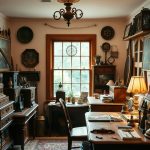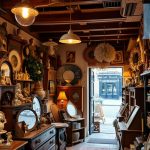The UK antique market is booming, drawing in more collectors and enthusiasts. This guide is perfect for those keen to dive into the world of antiques. It covers everything from furniture and art to unique jewellery, offering something for every collector.
We’ll share insights on various antiques, how to value them, and tips for smart buying. This guide is for both new and seasoned collectors. It aims to give you the knowledge to navigate the UK antique market with confidence.
Key Takeaways
- The UK antique market is growing, attracting more collectors.
- This guide will help you understand the essentials of antique buying.
- Explore different types of antiques and their appeal.
- Learn how to appraise and value your antiques properly.
- Get tips tailored for first-time buyers navigating the market.
- Identify genuine antiques versus reproductions effectively.
Introduction to the UK Antique Market
The UK antique market has a long history that mirrors the country’s cultural and social changes. It has grown over centuries, influenced by important periods like the Georgian and Victorian eras. These times brought about styles and craftsmanship that shape today’s antique collecting.
Antiques like furniture, ceramics, jewellery, and artworks are key to understanding their periods. Movements such as the Arts and Crafts and Art Deco have added unique styles to the market. Knowing these influences helps us grasp the current trends in the UK antique market.
Today, the market is a mix of traditional and modern tastes. With a focus on sustainable living, more people choose antiques for their beauty and eco-friendliness. Antique fairs and exhibitions are popular, attracting many enthusiasts. They offer not just unique items but also the stories behind them.
Why Collect Antiques?
Collecting antiques is popular worldwide for many reasons. One key reason is the beauty and craftsmanship of these items. They often have a unique style and quality that modern items don’t match. This lets collectors show off their personal taste.
Antiques also offer a peek into the past. Each piece has its own story, linking us to different times and places. This makes collecting a way to learn about history in a hands-on way.
Another reason to collect antiques is their potential to increase in value. Some antiques can become more valuable over time. This makes collecting not just a hobby but also a smart investment.
But there’s more to it than just money. Collectors often feel a deep connection to their items. These pieces become part of their story, sharing their history with others. This storytelling aspect is a big reason people enjoy collecting antiques.
In short, collecting antiques is a rich and rewarding hobby. It combines beauty, history, investment, and personal stories. This makes it a captivating activity for many.
Different Types of Antiques
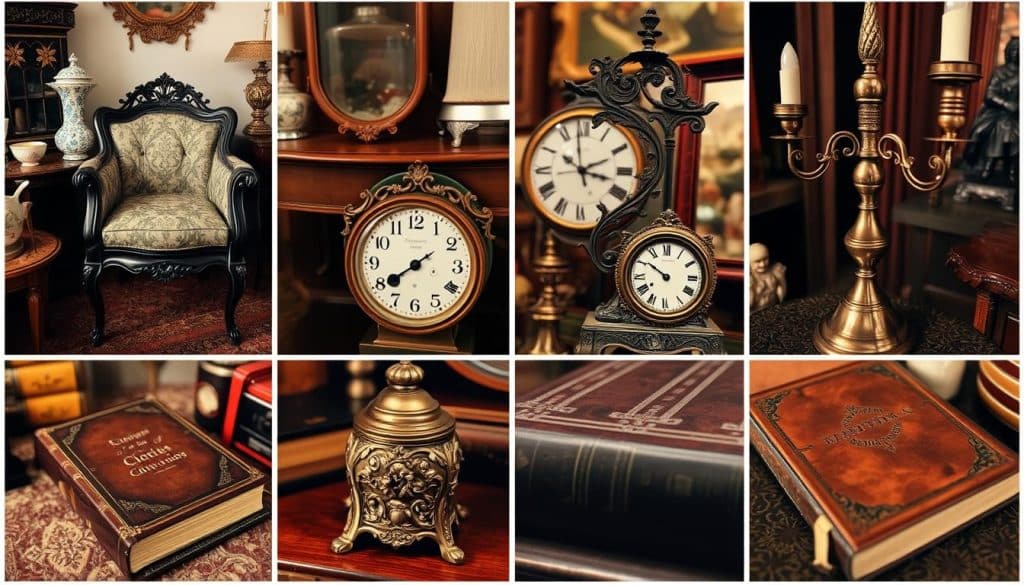
The world of antiques is full of variety, showing us the value of history and craftsmanship. It’s important to know the different types of antiques to understand their worth and beauty. This section will look at three main areas: furniture, art and paintings, and jewellery.
Furniture
Antique furniture shows the skill of craftsmen from the past. It includes everything from Victorian tables to Georgian chairs. The materials like mahogany, walnut, or oak tell us about when they were made. These pieces are not just useful but also make any room look beautiful with their detailed designs.
Collectors look for certain styles or makers to grow their collections.
Art and Paintings
Antique art is a big deal in the market, featuring works by famous artists and important movements. Collectors might like landscapes, portraits, or still life, each showing the art and values of its time. Knowing where a piece came from can make it more valuable and wanted.
Artists like J.M.W. Turner or Thomas Gainsborough mark key moments in British art history. They shape how we see antique art today.
Jewellery
Antique jewellery is loved for its beauty and history. The materials, like gold, silver, and precious stones, affect its value. Styles such as Art Deco or Victorian tell us about the era they were made in.
Knowing where an item came from is key for collectors. Pieces owned by famous people can greatly increase their value. Antique jewellery connects buyers with the past in a special way.
Understanding the Antique Market in the UK
The UK antiques market is lively, with many factors influencing what people buy and what’s in trend. There’s a big demand for unique, historical items. This keeps the market thriving, with both collectors and enthusiasts driving its growth.
Understanding the market means looking at the economy’s impact on what people can afford to buy. Prices change with demand and how things get from maker to buyer. This shows the UK antiques market is complex.
Auction houses and experienced dealers are key to the market’s success. They help buyers feel confident, leading to more people taking part in auctions and sales. Online platforms have changed how antiques are sold, making it easier for buyers to find items. This has made the market more competitive and influenced how sellers set prices.
Globalisation has brought new challenges and chances to the UK antiques market. Now, items from around the world are more easily found, offering collectors more variety. But, it also makes checking if an item is genuine harder, making market knowledge vital for everyone.
| Market Factor | Impact on UK Antiques Market |
|---|---|
| Supply and Demand | Fluctuations directly influence pricing and availability. |
| Auction Houses | Provide expertise and attract buyers, enhancing seller visibility. |
| Online Marketplaces | Expand market reach and increase competition for sellers. |
| Globalisation | Diversifies product offerings but complicates authenticity checks. |
Antique Appraisal and Valuation
Learning about antique appraisal is key for those interested in antiques. A professional appraisal is crucial to find out an item’s true value. This ensures buyers and sellers get fair prices. This guide will walk you through the appraisal process and what affects an antique’s value.
How to Get an Item Appraised
Finding a skilled appraiser is the first step in the appraisal process. Look for members of groups like the British Antique Dealers’ Association (BADA) or the Valuation Office Agency (VOA). Here’s what to do next:
- Research potential appraisers in your area.
- Check their credentials and experience in valuing antiques.
- Schedule an appointment to have your item evaluated.
- Prepare any documentation that may support your item’s history and provenance.
- Discuss the appraiser’s findings and ask for a written report.
This written report is vital for insurance, resale, or estate purposes. It details the appraisal and the appraiser’s conclusions.
Factors Influencing Value
Several factors greatly affect an antique’s value. Knowing these can help buyers and sellers make better choices. Key factors include:
- Age: Older items are often more valuable due to their historical importance.
- Condition: The item’s condition is a major factor in appraisal.
- Rarity: Items that are hard to find can command higher prices.
- Provenance: A documented history of ownership can boost an item’s appeal.
- Market Trends: Demand and trends can change, affecting value.
| Factor | Description | Impact on Value |
|---|---|---|
| Age | The length of time since the item’s creation | Higher age can increase value |
| Condition | The current state of the item | Poor condition decreases value, excellent condition increases it |
| Rarity | The availability of similar items | Scarcity can significantly increase value |
| Provenance | The item’s documented history | Strong provenance can elevate value considerably |
| Market Trends | Current tastes and demands in the antique market | Shifts can lead to fluctuations in value |
Tips for First-Time Antique Buyers
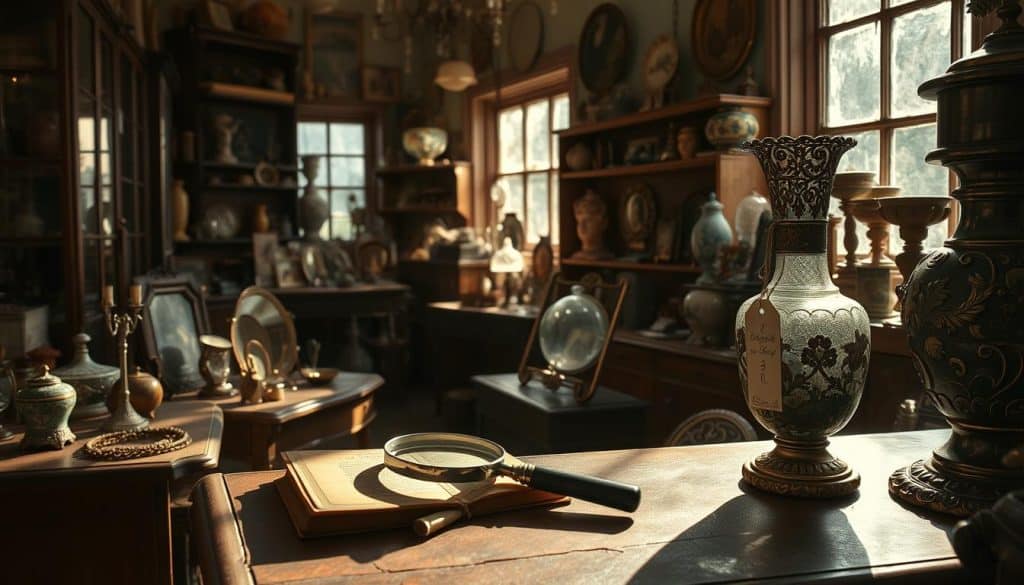
Starting your journey into antiques can be thrilling yet overwhelming, especially if it’s your first time. It’s important to be well-informed when buying antiques. Here are some key tips for beginners to help you enjoy collecting antiques.
Do your homework on the items you’re interested in. Knowing the history, craftsmanship, and what people want them for is key. You can learn a lot from books, antiques fairs, and online resources. These can guide you through different types and styles of antiques.
It’s crucial to check if an antique is real. Look for documents that prove its authenticity, especially for expensive items. Learning what real antiques look like can help you spot fakes. This is a vital tip for new collectors.
Knowing what things are worth can save you money. Compare prices from different places to make sure you’re paying a fair price. Watching auction results can also show you what’s currently in demand.
Don’t rush into buying. Take your time to find an item that fits your style or collection. Being patient can make you happier with your purchase and might even increase its value over time.
Finally, getting to know reputable dealers can be very helpful. They can offer insights and access to unique items. Whether it’s through shops or fairs, connecting with experts can lead to finding special pieces.
| Tip | Description |
|---|---|
| Research | Understand the history and value of items. |
| Verify Authenticity | Look for certificates of authenticity and knowledge of markings. |
| Know Market Prices | Compare prices and follow auction results to gauge value. |
| Exercise Patience | Avoid impulsive buys; wait for the right piece. |
| Network | Build relationships with antique dealers for exclusive access. |
Where to Buy Antiques in the UK
Looking for unique antiques takes you to different places in the UK. You can find them at antique fairs, charming shops, or online. Each place has its own benefits for buying antiques in the UK. Knowing where to look helps you make better choices.
Antique Fairs and Shows
Antique fairs and shows are perfect for those who love a variety of items. They bring together many dealers, offering a chance to find rare pieces and talk to experts. It’s a great way to compare prices and quality right there, helping you make smart buys.
Antique Shops and Dealers
Shopping at antique shops gives you a special experience. You can see a range of items and get advice from dealers who know their stuff. Look for shops that are part of the British Antique Dealers’ Association for peace of mind. These shops let you check out items closely and support businesses that love history.
Online Marketplaces
Buying antiques online is popular, offering lots of choices from home. Websites and big online stores have many listings. But, be careful when buying online. Check the seller’s ratings and read item descriptions to avoid bad deals.
| Buying Venue | Pros | Cons |
|---|---|---|
| Antique Fairs | Wide variety, face-to-face interaction | Can be time-consuming, varying quality |
| Antique Shops | Expertise, curated selection, instant access | May have higher prices, limited inventory |
| Online Marketplaces | Convenience, extensive choices | Risk of fakes, no tactile experience |
Identifying Fakes and Reproductions
When exploring the antique market, it’s crucial to be careful to avoid fake antiques. Telling real items from reproductions can be tricky. Knowing what to look for is key to spotting fakes.
Start by checking the item’s wear and tear. Real antiques show signs of age, like patina and wear that matches their age. Reproductions, however, often have uniform wear and look almost new, which could be a sign of a fake.
Look at the materials used to make the antique. Real antiques are made from materials that were around during their time. If an item uses materials that came later, it might be a fake. Certain plastics or synthetic finishes can also hint at its authenticity.
Provenance, or the item’s history, is also important. Items without clear histories or suspicious documents should make you wary. Checking provenance through records can help spot fakes.
Talking to experts or reputable appraisers is another smart move. They know how to check if an antique is real. Plus, there are online databases that can help you check information on specific items.
In summary, paying close attention to details is crucial in spotting fakes and reproductions. Knowing about wear patterns, materials, and provenance can help you tell real antiques from fakes.
| Red Flags | Authentic Antiques | Counterfeit Antiques |
|---|---|---|
| Wear and Tear | Natural signs of age and use | Uniform wear, looking almost new |
| Materials | Period-appropriate materials | Modern materials or synthetics |
| Provenance | Clear, documented history | Lack of reliable records |
| Expert Consultation | Professional appraisers accessible | No expertise available |
Negotiating Prices
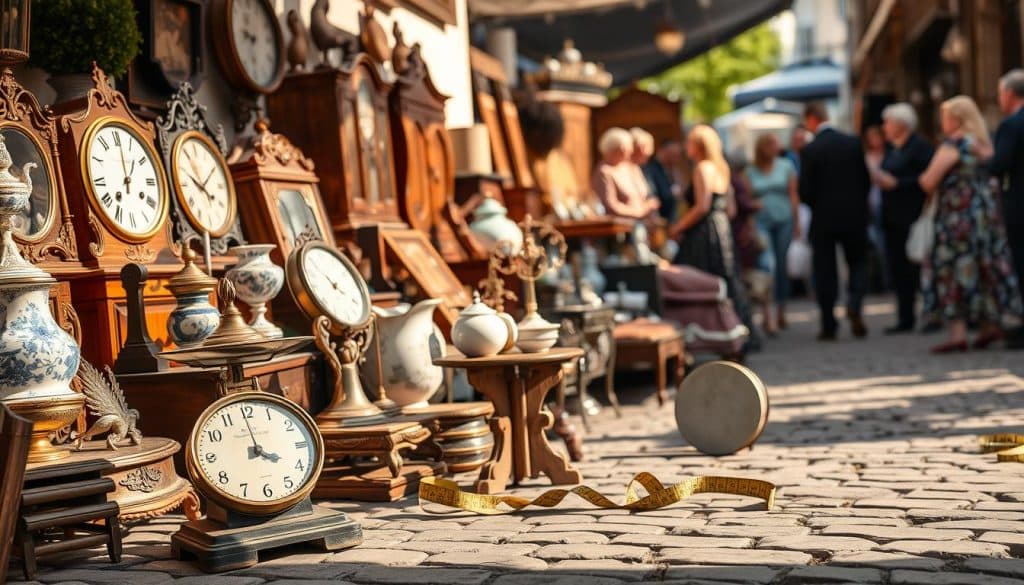
Mastering the art of negotiating vintage prices is key in the antique market. Preparation is crucial for getting good deals. Start by researching the item’s market value well. This knowledge gives you an edge during negotiations.
It’s important to set a budget before you start negotiating. Decide on the highest price you’re willing to pay. This keeps you focused and helps you stick to your budget when bargaining for antiques.
Respect and knowledge make negotiations smoother. Showing you know about the item’s history and value can build a good relationship with the seller. This often leads to better deals and respect from both sides. Showing real interest in the antique can make negotiations more positive.
Good communication is key. Speak clearly and listen to what the seller says. Being responsive can help find a deal that works for both of you. Always be polite and patient, as building a good rapport is key to negotiating prices well.
Using these tips can boost your confidence in negotiating for antiques. It can lead to getting the pieces you want for your collection.
Care and Preservation of Antiques
Looking after antiques means paying close attention to their care. It’s important to know how to clean them safely and store them right. This helps keep antiques in top shape. By doing things the right way, collectors can make their items last longer. They will stay beautiful and useful.
Cleaning Techniques
Cleaning antiques the right way is key to avoid damage. Here are some tips for different materials:
- Wood: Use a soft cloth and a mix of mild soap and water. Stay away from harsh chemicals, as they can damage the finish and the wood.
- Metal: For silver, use a gentle polish made for silverware. Other metals might need special cleaners without abrasives.
- Textiles: Dust regularly. For a deeper clean, get a professional who knows about antique textiles. Water can cause permanent damage.
- Glass: A mix of vinegar and water is good for cleaning glass antiques. Always use a soft cloth to prevent scratches.
Storage Tips
Storing antiques safely is very important. Here are some tips for keeping them in good condition:
- Keep them in a place with controlled climate, with low humidity to stop warping or mould.
- Use boxes made of acid-free materials for textiles and papers to stop them from fading or getting damaged.
- Put delicate furniture on padded hangers or shelves covered with felt to prevent scratches.
- Don’t put them in direct sunlight, as it can fade colours and damage finishes.
| Material | Cleaning Method | Storage Advice |
|---|---|---|
| Wood | Mild soap and water with a soft cloth | Keep in a humid-free environment |
| Metal | Gentle, non-abrasive polishes | Store away from moisture |
| Textiles | Dust frequently; consult professionals for deep cleaning | Use acid-free boxes |
| Glass | Vinegar and water solution with a soft cloth | Avoid prolonged sunlight exposure |
Trends in the UK Antique Market
The UK antique market has changed a lot in recent years. Now, people love vintage items that are good for the planet. They want things that have history and help us live more sustainably. These items let people show off their unique style and help the environment.
Mid-century modern furniture is very popular now. It’s known for its simple design and practicality. People who love antiques and newcomers alike find it appealing. Vintage textiles from the Art Deco era are also in high demand. They add colour and texture to modern homes.
Social media has played a big role in making antiques popular again. Sites like Instagram show antiques in new settings. This has made younger people interested in collecting, bringing back styles from the 70s and 80s.
Younger buyers are looking for items with a story or that remind them of the past. They prefer collections that are a mix of different styles. This mix of old and new makes the antique market exciting and fresh.
| Current Trends | Popular Antiques | Generational Insights |
|---|---|---|
| Sustainability | Mid-century modern furniture | Interest from younger collectors |
| Vintage styling | Art Deco textiles | Preference for eclectic collections |
| Social media influence | Retro items from the 70s and 80s | Emphasis on storytelling |
The Legislative Environment for Antiques
The UK’s antique market is shaped by strict antique laws. These laws cover buying, selling, and keeping historical items safe. They make sure the trade is fair and items are looked after for the future.
Proving where antiques come from is key. Sellers must show they are genuine. This builds trust and stops the trade in stolen items. Also, some antiques can’t be taken out of the country, protecting our heritage.
Groups like Arts Council England help with these rules. They guide on how to trade antiques right and work on policies to keep our history safe.
| Legislation | Overview |
|---|---|
| The Theft Act 1968 | Addresses the handling of stolen goods, including antiques, ensuring that stolen items cannot be legally sold. |
| Cultural Property (Protection) Act 1984 | Aims to protect cultural property and restrict the export of artefacts deemed culturally significant. |
| The Export Control Act 2002 | Regulates the export of antiques, placing controls on certain items to maintain national heritage. |
| Anti-Money Laundering Regulations | Requires businesses involved in the sale of antiques to comply with measures to prevent money laundering. |
Knowing the laws helps collectors and dealers trade responsibly. It leads to a strong antique trade that respects history and promotes careful buying and selling.
Connecting with Antique Communities
Joining the antique community in the UK can make collecting antiques more exciting. By being part of antique groups, both online and in person, you learn a lot and make friends with others who love antiques. These groups often have meetings where people talk about their finds, share how to fix things, and plan trips to big fairs or markets.
Now, it’s easier to meet people who like antiques thanks to the internet. Social media and forums are great for sharing tips, learning new things, and talking about different antiques. Groups like the Antiques Trade Gazette also have events and resources for collectors, helping everyone feel part of a big community.
Going to events is key to keeping up with trends and finding new items. These events let people swap stories, work together on projects, and learn from each other. Being part of the antique community in the UK means you get to enjoy many benefits, making your antique journey more interesting and rewarding.









